|

10 steps to covering war in the
21st century for North American news producers (who want to keep
their jobs)
|
1.
Bombard the news with images of the latest monstrous face
of evil and constantly play up the threat he poses to the
good people of the world. Intercut images of evil man with
military target shots, and occasional images of Hitler. Completely
ignore the context and political complexity of the factors
contributing to the conflict situation, particularly any role
'our side' might play in it. Portray the military action as
really just a hunt for the evil man, as well as collective
punishment for those who harbor and support him (regardless
of whether they do or not).
|
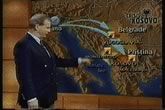 |
2.
Using the latest in computer graphic design, repeatedly display
maps of places most people haven't heard of with military
commentators using more fancy graphics to show the plan of
attack and possible targets.
|
|
3.
Starting with the obligatory speech by the president of the
Unites States, broadcast speeches by the political leaders
of western countries proclaiming their defense of goodness,
freedom, and the civilized world against the evil doers of
the designated target country.
|
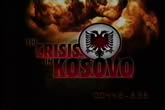

|
4.
Develop eye-catching logos and computer graphics for news broadcasts
that turn the war into an entertaining mini-series. Develop
a new
brand for each new war. |


|
5.
Show constant sequences of NATO military planes and ships preparing
for military manoeuvres to drive home our endless state of preparation
for war. Lots of idling planes, air base scenes, and soldiers
packing their bags and saying goodbye to family. |
|
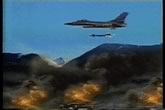

|
6.
As the conflict escalates, show lots of images of missiles
being fired from ships, aerial bombardment, and spectacular
fireworks. Describe these missile launchings as beautiful,
picture perfect, as 'lighting up the night sky'. Applaud the
work done by "our" troops, "our" boys,
"our side" to demonstrate your identification with
the side of freedom and goodness against monstrous evil. Show
images of destroyed buildings and smoldering rubble from time
to time, but rarely, if ever, show the impacts on civilians
of these' fireworks'.
|
|
|
7.
When civilians of the enemy population react with anger at being
attacked (after September 11th, even North Americans now know
that there is something about being bombed that makes people
crazy), show lots of images of angry, irrational mobs breaking
things and burning American flags. Do not contextualize what
they are reacting to. If you must interview members of the enemy
group, try to showcase the most extreme, crazy-looking or violent
ones. |
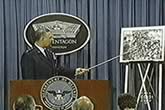 |
8.
Repeat whatever the PR companies hired by the designated "good
guys" of the war want circulated as part of the branding
of that war (cf. Hill & Knowlton's work for the Kuwaitis
during the Gulf War). Likewise with NATO and Pentagon press
briefings. Above all, don't ask any challenging questions, as
you will be denied privileged access to these officials and
cut out of the information loop they manage in the future. To
survive, stick to the military press pool system (or more recently,
the embedded team reporters) run by the Pentagon or NATO at
all times. |
|
9.
Cut down on the number of interviewees and commentators from
the civilian population of your country, particularly those
holding an antiwar position. Dramatically escalate the number
of guests and commentators from the defense sector, military
and intelligence personnel. Underreport any antiwar demonstrations
that take place. |
|

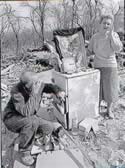
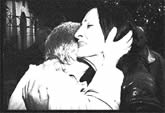
|
10. As the conflict
shifts into full-gear, show endless video game-style footage
of the bombings supplied to you directly by the military.
What you're after is almost the exact inverse of the media
coverage of September 11th.
Do not endlessly
repeat point of view shots from the ground that show the impacts
of a building being bombed on a human scale, as was done with
the continuous feed of images of the World Trade Centre crumbling.
Make sure that the overwhelmingly dominant image is the equivalent
of showing the impacts of the September 11th tragedy strictly
via the radar screen on one of the airplanes that hit the
towers. Avoid or at least minimize images such as the bottom
two pictures on the left.
|
|
Repeat
these steps in a constant, never-ending loop, especially steps
1, 5, 6, 8 and 10. |
|